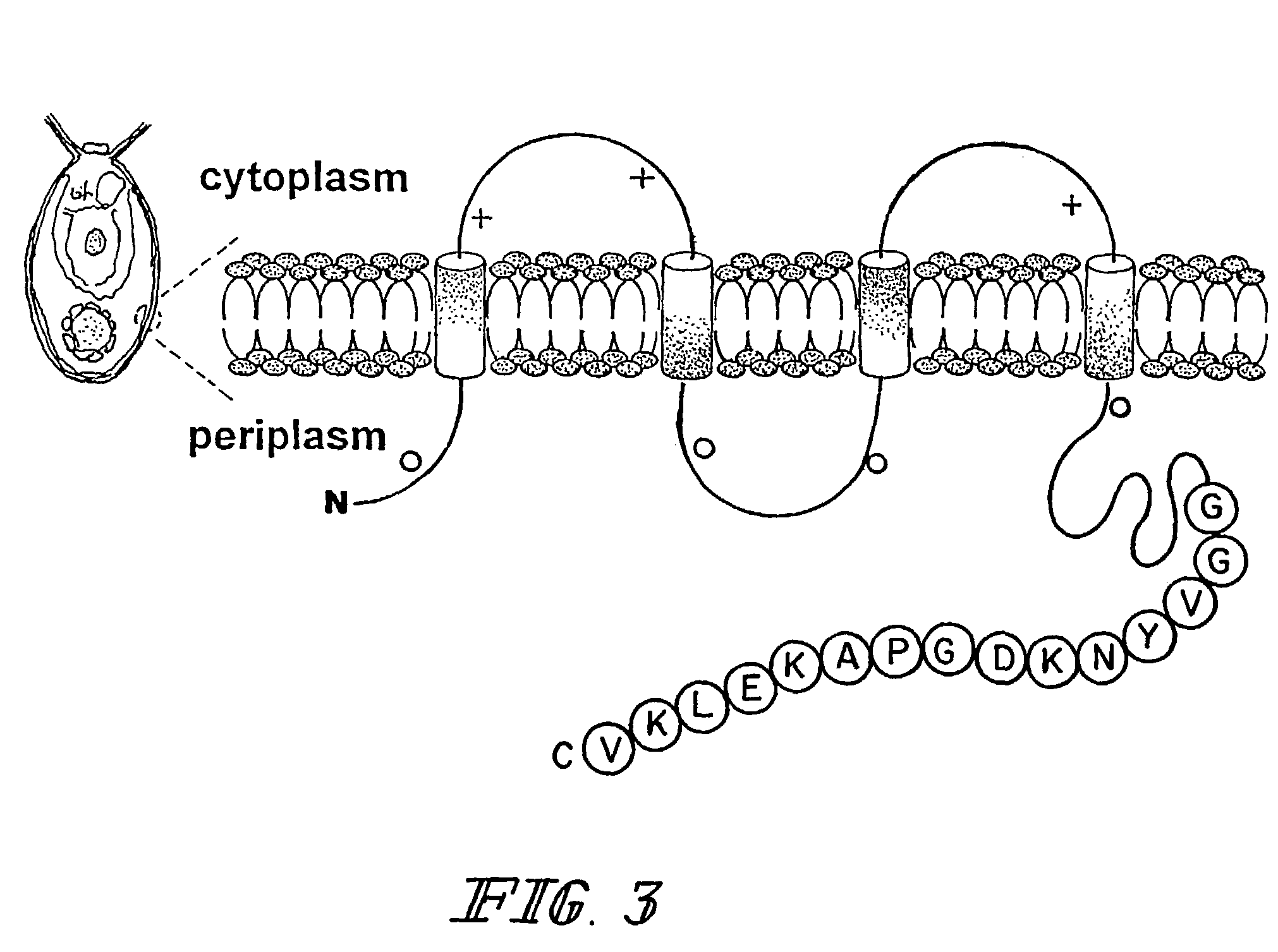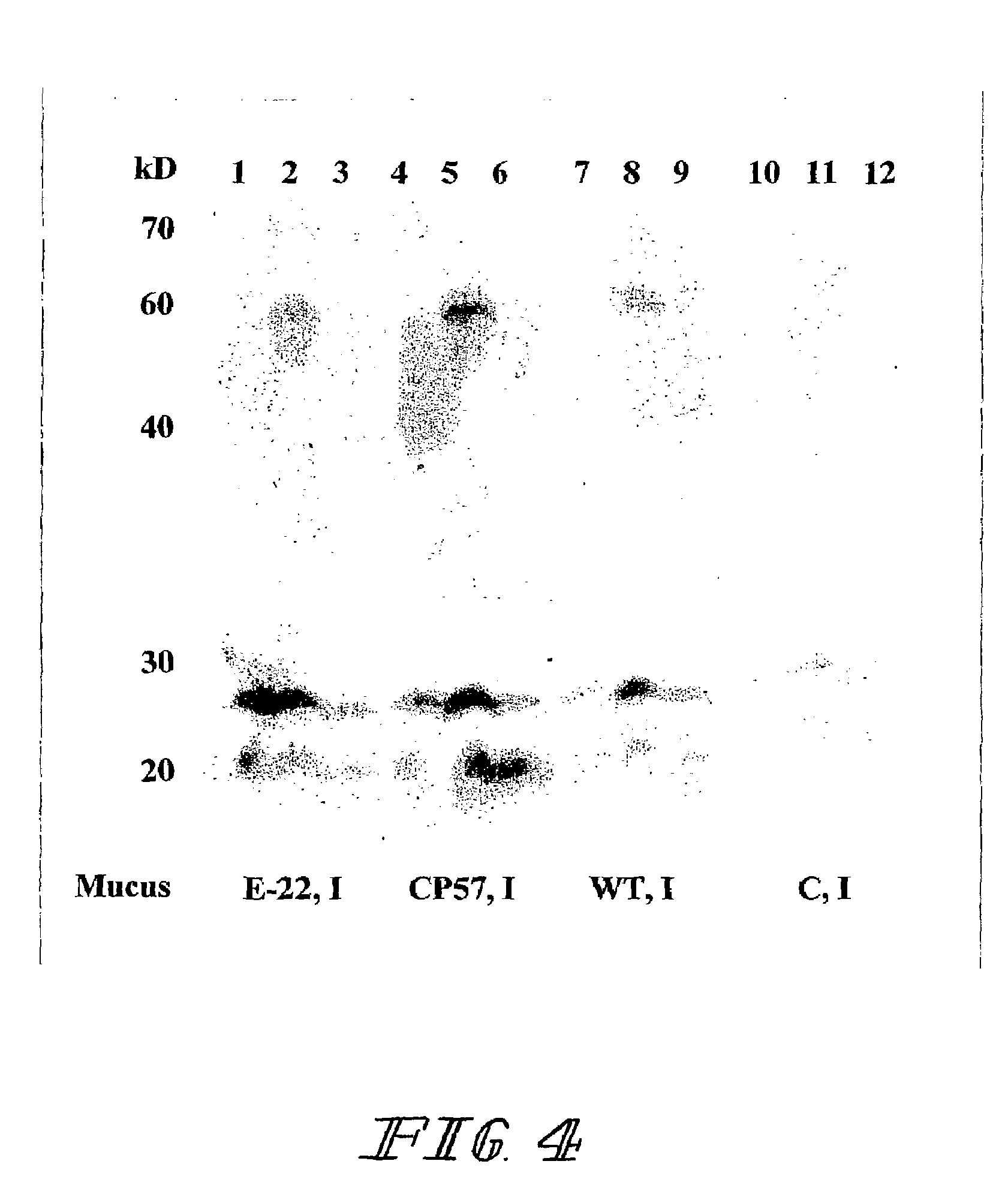Transgenic algae for delivering antigens to an animal
a technology of transgenic algae and antigens, applied in the field of transgenic algae for delivering antigens to an animal, can solve the problems of unsatisfactory properties of such drugs, affecting and affecting the survival of animals, so as to improve the expression of antigen determinants
- Summary
- Abstract
- Description
- Claims
- Application Information
AI Technical Summary
Benefits of technology
Problems solved by technology
Method used
Image
Examples
example 1
Transgenic Algae Expressing the P57 Immunogen from Rennibacterium salmoninarum
[0078]Rennibacterium salmoninarum is the etiologic agent for bacterial kidney disease, the most common disease of farmed salmonoids. A transgenic algae expressing an antigenic determinant of the fish pathogen. R.salmoninarum was prepared using a portion of the P57 leucocyte agglutinizing protein (Genbank accession no. AF123889) of Rennibacterium salmoninarum for surface display as an antigen.
[0079]A highly antigenic determinant of the P57 protein encoding the amino acids VYNKDGPAKELKV, (SEQ ID NO: 1) residues 112-124, was identified using the program Sciprotein, Scivision (Burlington, Mass.). The following is a synthetic oligonucleotide encoding this peptide and using the codon bias preferred for expression of nuclear genes in the alga Chlamydomomas reinhardtii:
[0080]
(SEQ ID NO.2)5′-GATCTAGATTAACCTTCAGCTCCTTGGCGGGGCCGTCCTTGTTGTACACGCCCCCACCTTGGTGCGCCGTCAGAG-3′
The above synthetic oligonucleotide was used t...
example 2
Immersion
[0091]Transgenic Chlamydomonas reinhardtii expressing the P57 protein from Rennibacterium salmoninarum as a fusion protein on the plasma membrane (called E-22 algae) or in the chloroplast (called CP57 algae) were constructed as described in Example 1. Control algae (the CC-2137 strain of C. reinhardtii) were also used to test administration by immerson.
[0092]The algae were grown in tris-acetate-phosphate (TAP) medium. See Gorman D S and Levine R P (1965), Proc. Nat. Acad. Sci. 54: 1665-1669, to a density of 1×106 cells / ml at 22-27° C. with 10 μmol photons / m2 / sec illumination from fluorescent tubes. The algal cells were harvested by centrifugation and resuspended in water to a density of approximately 1×106 cells / ml.
[0093]Rainbow trout juveniles (average initial weight, 9.1±0.5 g) were subjected to a bath treatment in water containing algae in a 20 L barrel container (one barrel containing each of the E-22, CP57 and CC-744 algae). Exposure of the trout to the various algae w...
example 3
Feed Pellet
[0098]Transgenic Chlamydomonas reinhardtii expressing the P57 protein from Rennibacterium salmoninarum as a fusion protein on the plasma membrane (called E-22 algae) or in the chloroplast (called CP57 algae) were prepared as described in Example 1.
[0099]The algae were grown in TAP medium as described above in Example 2 to a density of 1×106 cells / ml. The algal cells were harvested by centrifugation, frozen in liquid nitrogen and freeze-dried.
[0100]Three semi-purified diets formulated based on casein-gelatin as a protein source were used for oral administration. The three semi-purified diets were isonitrogenous and isocaloric to incorporate 4% (on dry weight basis) of three different types of algae. The three algae were E-22, CP57, and CC-2137. Five percent of fish protein concentrate (CPSP 90, Sopropeche S. A., Boulogne-Sur-Mer, France) was supplemented into the diets to enhance their palatability. The dietary ingredients were mixed with distilled water and cold-pelleted ...
PUM
| Property | Measurement | Unit |
|---|---|---|
| weight | aaaaa | aaaaa |
| temperature | aaaaa | aaaaa |
| time | aaaaa | aaaaa |
Abstract
Description
Claims
Application Information
 Login to View More
Login to View More - R&D
- Intellectual Property
- Life Sciences
- Materials
- Tech Scout
- Unparalleled Data Quality
- Higher Quality Content
- 60% Fewer Hallucinations
Browse by: Latest US Patents, China's latest patents, Technical Efficacy Thesaurus, Application Domain, Technology Topic, Popular Technical Reports.
© 2025 PatSnap. All rights reserved.Legal|Privacy policy|Modern Slavery Act Transparency Statement|Sitemap|About US| Contact US: help@patsnap.com



